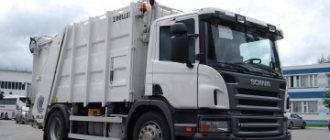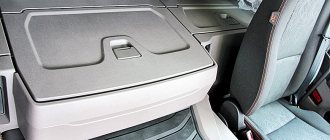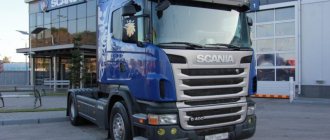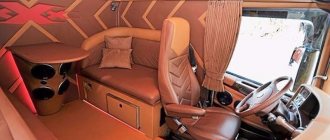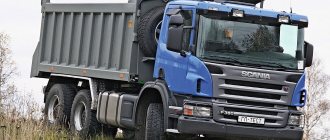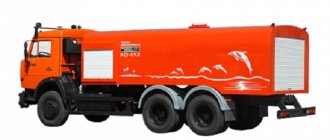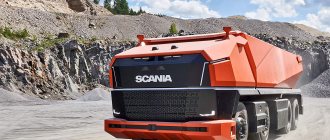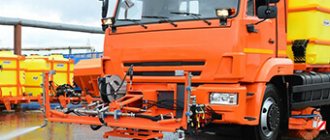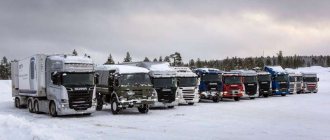Scania cars
Today the Swedish brand Scania belongs to the Volkswagen Group. For many years, Scania has been known primarily for its trucks - but few people remember that Scania once also produced passenger cars. True, that was a very long time ago.
The Scania company was founded in 1900 and began with the production of bicycles, and a year later it released the first passenger car, now known as the Scania A1 (it did not have its own name then). Two years later, sales of passenger cars began, and in 1909 Scania introduced the first truck. Automobile production was boosted in 1911 by the merger of Scania with another company, Vabis.
The Scania-Vabis concern produced passenger cars until 1929. Due to another economic crisis, the company was forced to focus on trucks as a more profitable line of production - a tradition that has continued to this day.
1901, the first Scania passenger car. The car has been preserved and is on display in the company museum. 1901, the first Scania in front of the factory gates in Malmö.
1904, Scania Type A, 14 hp
At the wheel is Prince Gustav, who three years later will be crowned King Gustav V of Sweden.
1908, Scania Type G, 12 hp.
Skånska Dagbladet newspaper delivery van.
1914, Scania-Vabis Typ I, 22hp.
The first passenger model after the merger of Scania and Vabis was produced from 1914 to 1925, although only 305 copies were produced in different bodies.
1917, Scania-Vabis Typ I.
1920, Scania-Vabis Typ III with a limousine body.
1920, Scania-Vabis Typ IIIS, utility van.
1929, Scania-Vabis Type 2122 4-Door Sedan.
The latest passenger car model from Scania. These American-style cars were produced from 1927 to 1929 on special orders.
Source:
Related links:
fishki.net
Scania Stock Photo, Picture And Royalty Free Image.
#44746934 — SALO, FINLAND — AUGUST 29, 2015: White Scania Touring coach bus..
Editorial
Similar images
Add to Likebox
#44747026 – SALO, FINLAND – AUGUST 29, 2015: White Scania Touring and VDL..
Editorial
Similar images
Add to Likebox
#53643255 — Kiev, Ukraine — February 24, 2016: Collection of popular car..
Editorial
Similar images
Add to Likebox
#98547616 — Ales Stones: The iron age Ales Stones in Skane, Sweden
Similar images
Add to Likebox
#98499000 — Malmo — October 22, 2022: Historic center of Malmo, Sweden Editorial
Similar images
Add to Likebox
#98563018 — Ystad — October 22, 2022: Interior of Saint Marys Church at the..
Editorial
Similar images
Add to Likebox
#68952875 — Skarhult slott is a castle in Eslov Municipality, Scania, in..
Editorial
Similar images
Add to Likebox
#93053327 — Architecture from the Trolle-Ljungby Castle in southern Sweden..
Similar images
Add to Likebox
#83715782 — Old rural stone church in Simrishamn, Sweden
Similar images
Add to Likebox
#92079362 - Vasteras, Sweden - July 5, 2013; Fire truck Scania-Vabis 3258..
Editorial
Similar images
Add to Likebox
#73190375 — Lutheran Church
Similar images
Add to Likebox
#98563071 — Lund — October 21, 2022: Streets of the historic center of Lund,.. Editorial
Similar images
Add to Likebox
#105493238 – CHIANG MAI, THAILAND – SEPTEMBER 8 2011: Bus of Intratour. Photo..
Editorial
Similar images
Add to Likebox
#85872952 — Image of Tosterup chapel, with its traditional Swedish white-washed..
Editorial
Similar images
Add to Likebox
#94282832 — Winter landscape with still lake. Helsingborg, Sweden.
Similar images
Add to Likebox
#98548631 — Ales Stones: The iron age Ales Stones in Skane, Sweden
Similar images
Add to Likebox
#68952868 — Backaskog castle in the northern region of skane,sweden
Editorial
Similar images
ru.123rf.com
Brand history, model catalog and technical specifications
Scania - history of the brand:
Scania AB is Sweden's largest manufacturer of trucks and buses, produced since 1920. The company is located in Södertälje, and its shareholders are MAN and Volkswagen AG. From the first days of operation, the company managed to gain excellent competition among other representatives and authority. It was distinguished by the quality of production, but did not have sufficient financial resources.
Already in October 1910, management began negotiations on a merger with its main competitors and in March the automobile manufacturing enterprises were closed. Scania-Vabis has created all the production and technical prerequisites that have become leaders in this field of work. 50 years later, the company’s previous name, Scania, began to make its way onto the market. This happened due to the company’s successful signing of an agreement with the Swedish automobile and aviation company SAAB. In Sweden in 1960, a completely new production association SAAB-Scania appeared and all previously produced cars were named Scania.
In 1970, the company began to expand its assembly plants and as a result, one large branch appeared, and various plants began to open in Monaco, Morocco, Iraq and the United States. The volume of car production at that time increased several times. The company's authority took a leading position and was rapidly moving towards victory in the global auto market. In 1980, the third generation Scania trucks began to be produced, weighing up to 32 tons. At this time, the company completely abandoned 8-liter engines, while giving preference to 9.11-liter working engines.
The fourth generation trucks were released in 1996, at a time when the Italian body studio system was connected. These were trucks produced in a new design, the gross weight of which was 48 tons. Now available in 300 different types. The cabins were the most comfortable in the Topline design along with sleeping places. By the end of 1999, the company's position was quite strong and stable. In addition to producing well-known trucks, Scania produces a more advanced range of bus chassis, industrial and marine installations. In 1901, more than 800 types of cars were created. Scania owns six Swiss factories and eight large overseas sites, employing approximately 23,800 people. Despite this, the competition led to the fact that all the shares ended up with the main competitor of the Swiss company Volvo. Already in April 1999, the share of production exceeded 70%. Therefore, Scania formed a subsidiary and continued producing trucks until 2000.
a2goos.com
How and where are custom Scanias made?
Today, every global manufacturer has a large number of models and modifications that cover the typical needs of customers. However, sometimes the buyer requires something highly specialized for special operations, in a single quantity. But for the sake of piece goods, huge factories cannot disrupt the standard assembly conveyor cycle by adding special technological operations and special logistics. Here small studios - “remodelers” - come to their aid. Previously, these companies were independent, but now they are mostly owned by concerns. Today, there are two dozen such organizations in Europe alone - among them there are relatively large ones, whose annual production is hundreds of cars, and tiny ones, which assemble a couple of dozen cars a year.
The interaction scheme has been worked out for decades: the studio undergoes an audit of the machine manufacturer, receiving approval for its special units and units. And the parent concern redirects orders for non-standard cars to this studio. And the client usually doesn’t even realize that his truck was assembled not at the main plant, but in a separate third-party workshop. In this case, all warranty obligations, of course, are borne by the parent organization.
If we talk directly about brands, then Mercedes has Paul and Titan, Volvo has Popp and Bas, and MAN has Toni Maurer. Scania also has its own specialization shop.
This is a small company called Laxå, named after the Swedish town where it is located. In the late 1950s it was a mechanical workshop called Fordonsskräddarna. Having become one of the Scania-Vabis dealers, the company gradually began modifying the original machines to suit the needs of customers. And she has made great progress in this, especially in redesigning the cabins. In all subsequent years, cooperation with Scania has developed successfully, and since 2022 Lakso is completely owned by it, having turned into a workshop of special machines.
The main share of production is still occupied by equipment with non-standard cabins. First of all, these are double cabins for fire crews, with their own name CrewCab. They are available in two sizes: regular, 3120 mm long, and extended up to 3420 mm. They differ from regular ones, in addition to their size, in additional air conditioning for the rear row (capacity - up to eight people) and airbags under the roof. In addition to dual ones, they also produce special single versions like Longline cabins, and one-piece versions for prototypes from the Svempa studio.
The same company also produces regular L-series cabins with a lower floor level. Most of them are installed on utility vehicles, but there are also delivery vehicles and even tractors with this configuration.
New modification in the Laxå program - electric tractors with a pantograph
In addition to cabins, Lakso also assembles custom chassis. There are an endless number of options - after all, the process is carried out manually. It is possible to lengthen or shorten the frame, change the track width and the location of the axles. Adding or removing an axle: driving or non-driving, pivoting or fixed, lifting or non-lifting, with single or dual wheels. Suspension modification: installation of reinforced, mechanical instead of pneumatic or vice versa. Replacement of a special gearbox, installation of a transfer case and power take-off. They also service and repair special vehicles and also produce spare parts for them.
Of course, being part of the parent concern, Lakso uses the same modern equipment, and the computer control system is connected to a common inter-plant network. Today there are 160 employees working there, who last year assembled about one and a half thousand special Scanias.
Scania trucks (Scania trucks) - model range, photos, reviews
Scania is a Swedish company engaged in the production and sale of heavy-duty vehicles. Basically, Scania products are export-oriented - approximately 95% of products are sold abroad, more than half of the assembly work is carried out outside of Sweden. Scania trucks are sold in markets of more than 100 countries in Europe, Latin America, Asia, Africa and Australia. The fastest growing market for new Scania trucks today is Russia.
Scania enterprises employ over 28,000 workers and employees. Cars are produced at factories in Sweden, the Netherlands, France, and Brazil.
Model range of Scania trucks and tractors
In 2006, Russia entered the top ten largest countries in terms of sales of new Scania trucks: during the year, the Swedish truck manufacturer delivered 2,820 new heavy-duty vehicles to consumers. Largely thanks to the special project Scania Griffin.
As a result of the modernization of the truck range, Scania in recent years has come to the following extremely simple division of trucks into three series: Scania R, Scania G and Scania P.
Scania R series trucks are aimed at the long-distance transportation segment and for use as a chassis for heavy special equipment. Scania P trucks with smaller cabs are aimed at the lighter vehicle segment with engines up to 420 hp. Finally, transporting heavy loads over long distances on bad roads is the main purpose of Scania G series vehicles. And for Russian consumers, Scania offers a special product - Scania Griffin.
Scania is represented on the Russian market by not only supplying high-quality equipment, but also offering a range of services - from financing the purchase of equipment, its maintenance to the subsequent purchase of client cars for the purchase of new Scania equipment.
Since May 2004, a plant for assembling Scania OmniLink CL94UB 4×2 buses has been operating in St. Petersburg. Sales centers are located in Moscow and St. Petersburg. Today there are already more than 10 Scania car service stations operating in Russia.
com-trans.net
Scania 4-series / Scania 4 Series
The fourth series or fourth generation of Scania replaces the third series in 1996 and is produced until 2004, when the PRG range appears.
A distinctive feature of Series 4 is a completely updated exterior, the work of Italian designers from the Bertone studio. From the front, the cars take on a square shape, merging further into more rounded and soft lines. At the same time, special attention is paid to the reliability of the vehicles - a rigid, durable cab frame, reinforced side and rear walls. In the new cab design, the radiator grille is divided into two parts horizontally. The lower one is folding, which makes access to the windshield easier, and also provides additional convenience to the driver in the form of an external bench. The cars are standardly equipped with three types of cabs: Day cab (day cab), Highline (extended), Topline - the most spacious, with a high roof and two berths.
The Scania Fourth Series includes medium-tonnage and heavy trucks with a gross weight from 18 to 48 tons in more than 300 variants of 2-, 3- and 4-axle base chassis, equipped with 6-cylinder diesel engines with power from 220 to 580 hp. : DSC9 – 220-310 hp; DC11 – 24-valve, 340-380 hp; DSC12 – 360-420 hp; DSC14 V8 - 460-530 hp; DC16 V8 – up to 580 hp Excellent performance and engine efficiency are the result of high torque at low speeds, as well as the implementation of the Opticruise transmission control system, which ensures optimal fuel consumption and reduced exhaust emissions. Information about the engine volume of cars of the fourth series is present in the indexing: 94, 114, 124, 144, where the last digit means that this is a car of the 4 series, and the first digits are the rounded engine volume. For example, 114 is an 11-liter 4-series engine. The letters indicate vehicle types (chassis class): L – long-haul tractors, D – trucks for regional transport, C – vehicles for construction work, G – vehicles for heavy-duty use. The 3-digit number on the opposite corner of the front panel of Scania cars indicates the engine power in horsepower.
, Scania 4-series vehicles were awarded the title of International Truck of the Year 1996.
